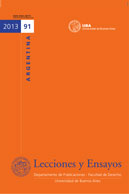El Estoppel: dificultades para definir una regla en derecho internacional y el rol deslucido de la Corte Internacional de Justicia
Palabras clave:
estoppel, preclusión, aquiescencia, silencio, confianza, buena fe, representaciónResumen
Nacido como instituto del common law, el estoppel fue introducido en el Derecho Internacional a través de laudos de árbitros británicos y norteamericanos en los siglos XIX y XX. Recogido luego –implícita o explícitamente– por la CPJI y la CIJ (Empréstitos Serbios, Estatus Legal de Groenlandia Oriental, Pesquerías, Plataforma Continental del Mar del Norte, entre otros), se ha convertido en una defensa perentoria de frecuente invocación. Sin embargo, la Corte Internacional no parece haber sabido precisar sus elementos constituyentes, derivando en una interpretación inconsistente del silencio y de la denominada detrimental reliance. Esto ha generado una incertidumbre que ha puesto incluso en duda la misma existencia del estoppel como regla del Derecho Internacional.
Descargas
Citas
BOWER, G.S. & TURNER, S.K., The Law Relating to Estoppel by Representation, 4ed, Lord Hailsham of St. Marylebone, 2004.
BROTÓNS, A., Derecho Internacional, Valencia, Tirant LoBlanch, 2007.
BROWN, C., “A comparative and critical assessment of estoppel in international law”, en University of Miami Law Review (50), 369-412, 1996.
CHAN, P., “Acquiescence/Estoppel in International Boundaries: Temple of Preah Vihear Revisited”, en Chinese Journal of International Law 2004, 3, 421-439.
— “Acquiescence/Estoppel in International Boundaries: Temple of Preah Vihear revisited”, Chinese Journal of International Law 2004, 3 (2): 421-439.
CHENG, B., General Principles of Law as Applied by International Courts and Tribunals, London, Cambridge University Press, 2006.
JOHNSON, D., “Acquisitive Prescription in International Law”, en B.Y.I.L (27), 332, 1950.
MARYLEBONE, LORD HAILSHAM OF ST., Halsbury's Laws of England, 4ed., UK, L.H. Marylebone, Ed, 1992.
OVCHAR, A., “Estoppel in the Jurisprudence of the ICJ.A principle of promoting stability threatens to undermine it”, en Bond Law Review 21 (1), Article 5, 2009.
Descargas
Publicado
Cómo citar
Número
Sección
Licencia

Esta obra está bajo una licencia internacional Creative Commons Atribución-NoComercial 4.0.











